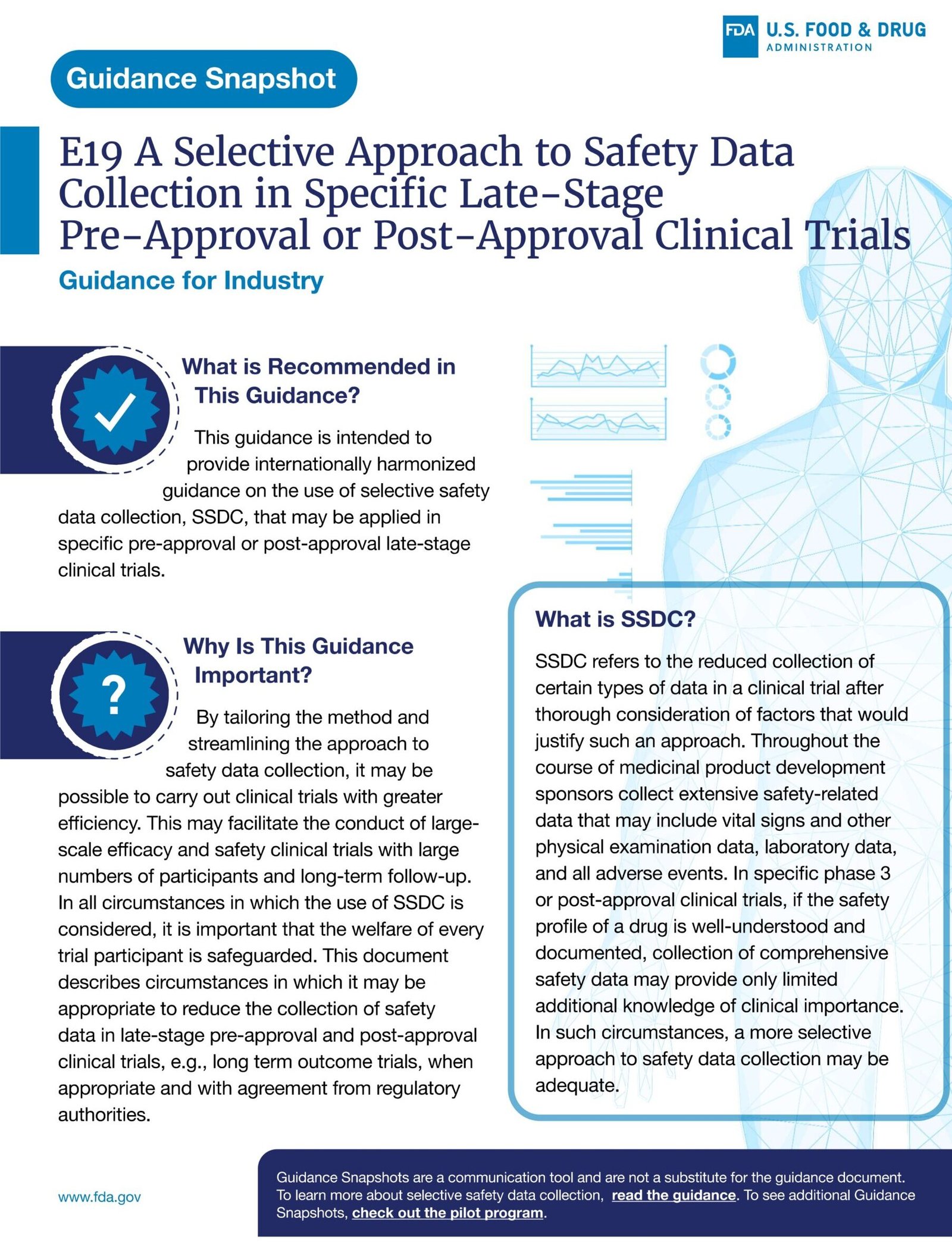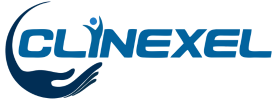Introduction
As the pharmaceutical industry embraces smarter, leaner, and more patient-centric approaches to clinical development, Selective Safety Data Collection (SSDC) has emerged as a pivotal strategy for improving the efficiency of late-stage and post-approval trials. In particular, the harmonization led by the International Council for Harmonisation (ICH) through the E19 guideline, in alignment with foundational principles in ICH E3 clinical study reports, marks a major evolution in how sponsors can optimize safety data collection without compromising regulatory rigor or patient welfare.
This blog delves into what (Selective Safety Data Collection) SSDC is, why it matters, and how it aligns with ICH guidance, especially E19 and E3, offering valuable insights for clinical operations teams, regulatory strategists, and safety professionals.

The Rationale: Why Streamline Safety Data?
Traditionally, clinical trials, especially those in late stages, have involved exhaustive safety data collection protocols. Sponsors routinely collect vast arrays of non-serious adverse events (AEs), extensive lab investigations, and physical assessments, even in settings where the drug’s safety profile is already well-characterized. While comprehensive, such over-collection burdens participants, investigators, and data management systems.
Selective Safety Data Collection (SSDC) proposes a risk-proportionate alternative: collecting only essential safety information, especially when prior data robustly characterizes a drug’s risk profile. This approach ensures regulatory compliance while improving trial efficiency, enrollment rates, and data quality of clinical trials data.
According to the ICH E19 guidance finalized in December 2022, (Selective Safety Data Collection) SSDC “may be applied in specific pre-approval or post-approval late-stage clinical trials” where the safety profile of a drug is well established (ICH, 2022).
Image Source: www.fda.gov
What Does ICH E19 Say?
The ICH E19 guideline provides an internationally harmonized framework for (Selective Safety Data Collection) SSDC, facilitating its adoption across multiple regulatory jurisdictions.
Key Principles of E19:
- Participant Safety Is Paramount: (Selective Safety Data Collection) SSDC does not compromise clinical care. Investigators are still expected to manage patients per best medical practices (ICH, 2022, Section 2.1).
- Selective, Not Sparse: Certain critical data must always be collected, e.g., serious adverse events (SAEs), AEs leading to study drug discontinuation, and AEs of special interest.
- Factors Supporting SSDC (Selective Safety Data Collection):
-
- Established regulatory approval
- Well-understood mechanism of action
- Consistent safety data from prior trials
- Similar population, dose, and duration
- Robust nonclinical and post-market safety data (ICH, 2022, Section 2.2)
- Implementation Models: E19 describes several models, including:
-
- SSDC for all trial participants
- SSDC for specific subpopulations
- SSDC after an initial comprehensive safety collection phase
- SSDC in representative subsets only (ICH, 2022, Section 3)
Integrating SSDC into Clinical Trial Design
ICH E3 clinical study reports continue to provide a vital structure for documenting (Selective Safety Data Collection)SSDC methodologies. Sponsors must clearly define what data is selectively collected to ensure regulatory clarity and transparency in final study reports.
1. Protocol Design and Statistical Planning
In alignment with ICH E3 (Structure and Content of Clinical Study Reports), the protocol must explicitly state which safety data will be selectively collected and justify the rationale. Statistical Analysis Plans (SAPs) should outline how data subsets will be analyzed to ensure interpretability.
2. Case Report Form (CRF) Design
CRFs must be tailored to ensure consistent, high-quality capture of required data. Training investigators becomes critical, particularly in trials using hybrid data collection methods, e.g., full safety data for one subgroup and SSDC for another.
3. Regulatory Engagement
Early and transparent dialogue with regulatory authorities is essential. E19 emphasizes pre-approval consultation to confirm that SSDC is appropriate and acceptable for the intended trial setting (ICH, 2022, Section 2.7).
Learning from Real-World Applications
The C3TI White Paper (2024) offers valuable case studies that demonstrate how (Selective Safety Data Collection) SSDC is currently being employed in various therapeutic domains.
Pragmatica-Lung Trial (Oncology)
Led by the NCI and FDA’s Oncology Center of Excellence, this trial used (Selective Safety Data Collection) SSDC by only collecting grade ≥3 AEs and serious unexpected events for pembrolizumab and ramucirumab, both with well-established safety profiles. The protocol omitted data on grade 1–2 AEs and routine labs, optimizing trial logistics without regulatory compromise (C3TI, 2024) (Reckamp et al, 2024)
VICTORION-2-PREVENT (Cardiovascular)
This large, multinational trial evaluating Inclisiran implemented (Selective Safety Data Collection) SSDC by limiting safety assessments to SAEs, AEs of special interest, and discontinuations. Routine labs and ECGs were reduced in frequency or omitted entirely for most participants (C3TI, 2024) (Marrs et al, 2023).
EMPA-KIDNEY & EMPACT-MI
With more than 16,000 patient-years of safety data, empagliflozin trials used (Selective Safety Data Collection) SSDC approaches that significantly reduced data collection burden. EMPACT-MI notably replaced in-person follow-ups with remote check-ins, collecting only selected AEs (e.g., ketoacidosis, liver injury) and discontinuations (C3TI, 2024) (EMPA-KIDNEY Collaborative Group, 2022) (Harrington et al, 2022)
Note: Effective (Selective Safety Data Collection) SSDC models rely on strong planning, which results in high-quality clinical trials data even with reduced inputs. Consistency in data capture and signal tracking remains critical for valid trial outcomes.
Addressing Misconceptions: What Selective Safety Data Collection Is Not About
Despite successes in the trials, uptake remains cautious. Common concerns include:
- Loss of granularity: Critics worry about the inability to detect subtle safety trends or label updates due to missing data.
- Regulatory variability: Some countries (e.g., parts of Asia or Latin America) still require full safety data collection, limiting global protocol harmonization.
- Data pooling challenges: Trials that switch from comprehensive to selective data capture midstream may face analytical complexity (ICH, 2022, Section 4).
ICH E19 acknowledges these limitations and recommends that sponsors plan prospectively for such scenarios. Protocol amendments, reversion to full data capture if concerns arise, and transparent reporting in study results can help mitigate these risks.
Expert Leadership in Clinical Trial Safety and Signal Detection at CLINEXEL
CLINEXEL experts bring deep domain knowledge and hands-on experience in clinical safety management, with a specialized focus on safety data collection in clinical trials. Dr Deepa’s expertise spans the design and implementation of robust pharmacovigilance strategies, including the use of validated electronic safety databases and cutting-edge signal detection tools.
CLINEXEL’s head of Pharmacovigilance, Dr Ranjit Chavan has played pivotal role in deploying technology-driven solutions and validated tools for early signal identification, enhancing pharmacovigilance in clinical trials and ensuring real-time surveillance of adverse events across global studies. Their leadership has been instrumental in establishing CLINEXEL’S validated systems for signal detection and management, enabling the timely identification, assessment, and reporting of safety signals in alignment with regulatory expectations. With a strong foundation in clinical trial safety oversight, Dr. Deepa and Dr. Ranjit exemplify Clinexel’s commitment to scientific rigor, operational efficiency, and patient safety.
SSDC and ICH E3: Harmonized Reporting
ICH E3, which defines the structure and content of clinical study reports (CSRs), remains relevant when reporting trials that implement SSDC. According to both E3 and E19:
-
- The methodology for SSDC must be documented in the CSR.
- Data summaries, in line with ICH E3 clinical study reports should include explicit descriptions of what was or wasn’t collected.
- Any limitations arising due to SSDC (Selective Safety Data Collection) must be described for proper interpretation.
Together, E3 and E19 offer a complete blueprint: from design to reporting. This integrates SSDC in line with global regulatory expectations.
Opportunities Ahead
The growing regulatory acceptance of SSDC (Selective Safety Data Collection) opens doors for broader adoption. Dr. Deepa quotes the FDA: “CDER communication with sponsors to implement SSDC (Selective Safety Data Collection)in appropriately identified trials will result in improved understanding of its real-world applicability, demonstration of its ability to facilitate efficient clinical trials, identification of potential challenges that programs encounter and ways to address those challenges, and promotion of best practices.’’
As more sponsors pilot (Selective Safety Data Collection) SSDC in diverse therapeutic areas, the industry is gradually building an evidence base for:
-
- Improved patient retention through lower burden
- Reduced costs from fewer site visits and labs
- Faster recruitment due to simplified protocols
- Streamlined global trials enabled through regulatory harmonization
Initiatives like FDA’s Center for Clinical Trial Innovation (C3TI) Demonstration Program aim to promote cross-stakeholder collaboration and accelerate the uptake of (Selective Safety Data Collection) SSDC in industry (FDA C3TI, 2024).
Conclusion
Selective Safety Data Collection is more than a regulatory trend; it is a paradigm shift. Grounded in science, enabled by harmonized ICH guidelines, and exemplified in large global trials, (Selective Safety Data Collection) SSDC balances operational efficiency with scientific rigor. As the ICH E19 framework gains traction globally, sponsors and (Contract Research Organizations) CROs that adopt (Selective Safety Data Collection) SSDC strategically will be better positioned to run leaner, more impactful trials. As Dr Ranjit aptly quotes the C3TI, “The lessons learned from the experiences in the SSDC Demonstration Program will help overcome the barriers to efficient drug development and facilitate faster access to safe and effective medicines.”
It’s time to rethink safety data collection more smartly. Connect with the expert team at CLINEXEL to explore how selective safety data collection, validated signal detection tools, and technology-driven pharmacovigilance solutions can optimize your clinical development programs. Reach out to our team to discuss customized approaches that align with global regulatory expectations while enhancing trial efficiency and patient safety.
Contact us today at info@clinexel.com to get started.
References:
- International Council for Harmonisation of Technical Requirements for Pharmaceuticals for Human Use (ICH). (2022). E19: A selective approach to safety data collection in specific late-stage pre-approval or post-approval clinical trials. https://www.ich.org/page/efficacy-guidelines
- U.S. Food and Drug Administration (FDA) & Center for Clinical Trial Innovation (C3TI). (2024). Selective Safety Data Collection – White Paper. https://www.fda.gov/about-fda/cder-center-clinical-trial-innovation-c3ti
- Reckamp, K. L., Redman, M. W., Dragnev, K. H., Iams, W. T., Henick, B. S., Miao, J., LeBlanc, M. L., Carrizosa, D. R., Herbst, R. S., Blanke, C. D., & Gray, J. E. (2024). SWOG S2302, PRAGMATICA-LUNG: A prospective randomized study of ramucirumab plus pembrolizumab (PR) versus standard of care (SOC) for participants previously treated with immunotherapy for stage IV or recurrent non-small cell lung cancer. Journal of Clinical Oncology, 42(16_suppl), TPS8657–TPS8657.
- Marrs, J. C., & Anderson, S. L. (2024). Inclisiran for the treatment of hypercholesterolaemia. Drugs in Context, 13, 1–9. https://doi.org/10.7573/dic.2023-12-3
- EMPA-KIDNEY Collaborative Group. (2022). Design, recruitment, and baseline characteristics of the EMPA-KIDNEY trial. Nephrology Dialysis Transplantation, 37(7), 1317–1329
- Harrington, J., Udell, J. A., Jones, W. S., Anker, S. D., Bhatt, D. L., Petrie, M. C., Vedin, O., Sumin, M., Zwiener, I., Hernandez, A. F., & Butler, J. (2022). Empagliflozin in patients post myocardial infarction: Rationale and design of the EMPACT-MI trial. American Heart Journal, 253, 86–98
Authors:
Dr Deepa Arora- CEO- CLINEXEL ( https://www.linkedin.com/in/deepaarora2019/ )
Dr Deepa is a physician with 25+ years of industry experience in leadership positions with pharma in Clinical Development, Medical Research and Drug Safety departments.
Dr. Deepa led an industry consortium for the implementation of additional risk minimization measures in Europe. Her experience includes development and execution of clinical development strategy and conducting clinical trials for NCEs, biosimilars, vaccines, complex generics and repurposed drugs.
Deepa has experience of interacting with various regulators- USFDA, EMA, MHRA, MEB, Health Canada, WHO, TGA for scientific advice, pre-IND meetings, end of phase meetings to discuss clinical development path, clinical trial designs and post marketing commitments including PMS/ Phase IV studies and paediatric investigation plan (PIP).
Dr Ranjit Chavan– Global Head Pharmacovigilance- CLINEXEL
( https://www.linkedin.com/in/dr-ranjit-chavan-907465222/ )
Dr Ranjit Chavan is a physician (M.B.B.S., Certification in Pharmacovigilance & Clinical Research) with 17 years of Drug Safety experience. Through his experience with global (Contract Research Organizations) CROs, he got the opportunity to work in global PV functions of leading MNC Pharma and understand their safety monitoring operations during clinical development as well as postmarked products.
He oversees comprehensive strategic decisions and conducts scientific assessments to enhance the effective use of drugs globally.
He successfully faced audits from EMA, MHRA, FDA, PMDA, Swissmedic, TGA, and various business partners audits, ensuring regulatory compliance and excellence.
